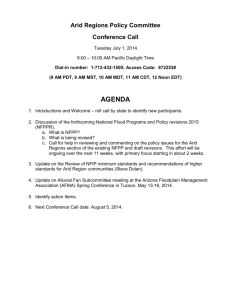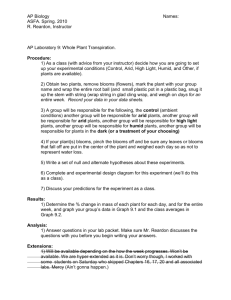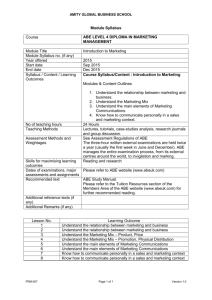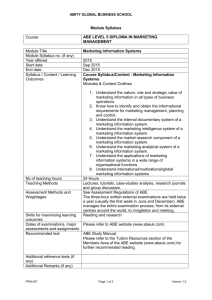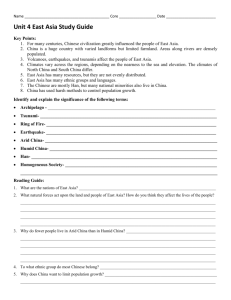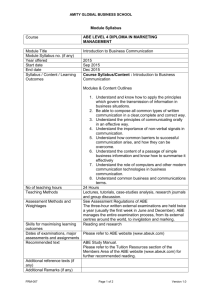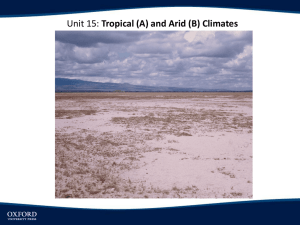Document 10545499
advertisement
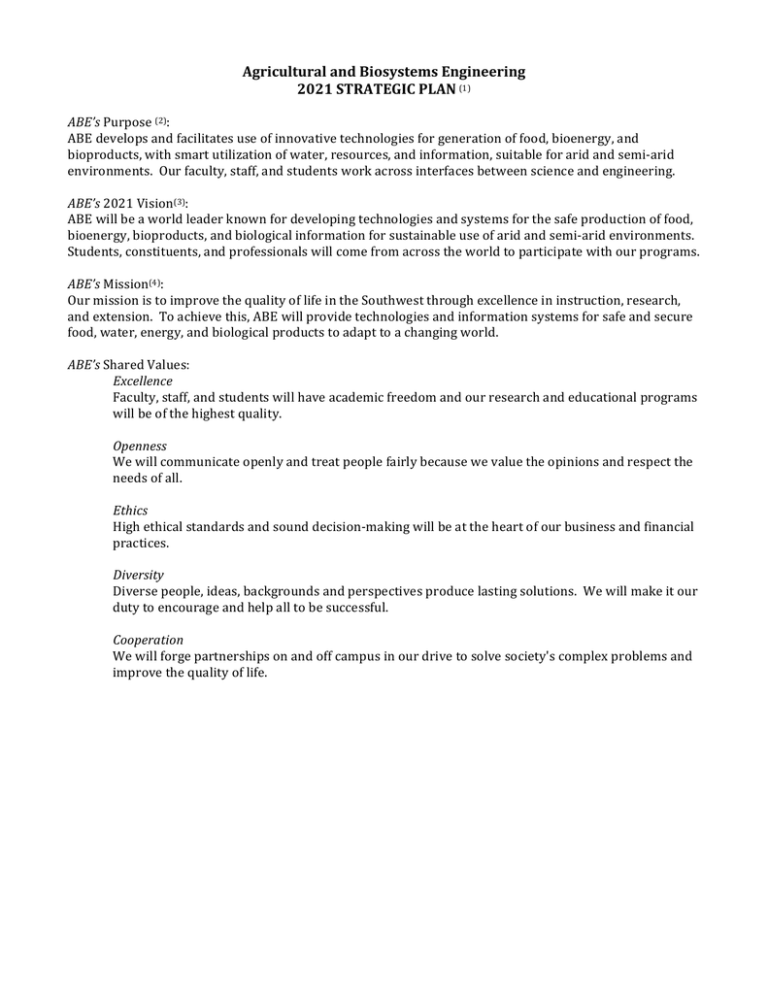
Agricultural and Biosystems Engineering 2021 STRATEGIC PLAN (1) ABE’s Purpose (2): ABE develops and facilitates use of innovative technologies for generation of food, bioenergy, and bioproducts, with smart utilization of water, resources, and information, suitable for arid and semi-­‐arid environments. Our faculty, staff, and students work across interfaces between science and engineering. ABE’s 2021 Vision(3): ABE will be a world leader known for developing technologies and systems for the safe production of food, bioenergy, bioproducts, and biological information for sustainable use of arid and semi-­‐arid environments. Students, constituents, and professionals will come from across the world to participate with our programs. ABE’s Mission(4): Our mission is to improve the quality of life in the Southwest through excellence in instruction, research, and extension. To achieve this, ABE will provide technologies and information systems for safe and secure food, water, energy, and biological products to adapt to a changing world. ABE’s Shared Values: Excellence Faculty, staff, and students will have academic freedom and our research and educational programs will be of the highest quality. Openness We will communicate openly and treat people fairly because we value the opinions and respect the needs of all. Ethics High ethical standards and sound decision-­‐making will be at the heart of our business and financial practices. Diversity Diverse people, ideas, backgrounds and perspectives produce lasting solutions. We will make it our duty to encourage and help all to be successful. Cooperation We will forge partnerships on and off campus in our drive to solve society's complex problems and improve the quality of life. STRATEGIC GOAL ONE: Facilitate the development of the sustainable Bioenergy & Bioproducts Industry in the Southwest U.S. and become the “go-­‐to” place for global development of arid land production of renewable biofuels and bioproducts. ABE Faculty: Choi, Cuello, Giacomelli, Kacira, Poe, Riley, Slack, Waller A. Current situation and gap between current situation and desired situation Arizona has great potential as a large-­‐scale producer of renewable bioenergy and bioproducts from sugar, oil, green waste, and algal sources. There currently is one full-­‐scale ethanol production facility in our region and we have been working with them to utilize new sources of biomass. ABE’s broad-­‐based research and teaching in this area and its depth of expertise could be leveraged into facilitating the launch of this industry statewide. Arizona could become a model for semi-­‐arid land production of renewable fuels demonstrating responsible use of water, land, and workforce. Utilization of residual biomass is a key step for economic feasibility of the industry. Gap: technology development is close for large use, economic assessments needed, further efficiencies and bioproducts development needed, private sector capital investments needed, workforce development, and broad acceptance from growers and the public. B. Strategy/ies to achieve goal 1) Build comprehensive teams, engage new partners, build infrastructure. 2) Obtain funding to support activities. 3) Perform innovative research and development and transfer to constituents. 4) Educate students and communicate with the public. C. Actions Time Period (Fiscal Years) Build comprehensive teams, engage new partners, build infrastructure. 1) Build a comprehensive team incorporating research in genetics, cultivation (field, bioreactor, algal raceways), product conversion, byproduct utilization (animal feed and value added products), economics, sustainability, and industrial production. Local partners can include (CHEE, PLS, SNRE, Chem, AREC, Nut Sci, WEST Center, bio5, SW C for Nat Prod, Solar energy groups; USDA-­‐ALARC, NREL, Sandia NL, Los Alamos NL). FY 12-­‐21 2) Work closely with private sector to expand production of bioenergy and bioproducts, engage Native American tribes and other under-­‐served communities who may grow feedstocks, and cultivate partners who can bring cost sharing / matching funds to support federally funded research. FY 12-­‐21 3) Facilitate on campus infrastructure for pilot-­‐scale production of biofuels (waste cooking oil to biodiesel, algae to biodiesel, sweet sorghum to ethanol) for research, teaching, and extension. FY 12-­‐13 4) Enhance publicity, web presence, and student recruiting. FY 12-­‐21 Obtain funding to support activities. 1) Engage DOE, USDA, NSF, ARPA-­‐E, DARPA; private sector investment; and state and local sources for research support. FY 12-­‐21 2) Work with private sector to facilitate funding from public and private sources for infrastructure. FY 12-­‐21 3) Seek funding for graduate students -­‐ National Needs Fellowships, NSF Fellowships, IGERT. FY 12-­‐21 Perform innovative research and development and transfer to constituents. 1) Perform economic impact and technology needs studies in collaboration with researchers, economists, local developers, industry, growers, and others as technology moves forward. FY 12-­‐15 2) Develop technological solutions key to economically viable methods for biomass production and use, incorporate life cycle assessments and systems analysis, for SW arid strategic advantages. FY 12-­‐18 3) Develop, coordinate, and translate research activities into facility, process, and product development with intellectual property (IP) protection based on sound technology and economic and environmental assessments with consideration of impact of climate change. FY 12-­‐18 4) Utilize information systems, genome to phenome methods, near and remote sensing to improve productivity in generating feedstocks while minimizing resource inputs. FY 15-­‐19 5) Develop platforms for production of valuable bioproducts including bioplastics, nutraceuticals, pharmaceuticals, animal feed, for the current environment and in response to climate change FY 14-­‐21 6) Develop platforms for utilization of green waste to recover energy. FY 17-­‐21 Educate students and communicate with the public. 1) Develop a comprehensive educational program including on-­‐line courses for students and practicing professionals with focus on arid land production of biofuels and bioproducts. FY 13-­‐16 2) Develop and strengthen communication channels with constituents, industry, state and local governments, and funding sources to improve public understanding of biofuels and bioproducts. FY 12-­‐21 3) Provide hands on experiences for HS students through college in community service projects, Engineering 102 projects, and lab / pilot projects in bioenergy production to foster development of workforce. FY 13-­‐15 4) Hire Extension specialists in bioenergy to facilitate industry growth and public understanding. FY 14-­‐16 5) Send faculty and UA administrators to Washington D.C. to meet program managers and gain insight; host visits to our facilities in AZ. FY 12-­‐21 D. Inputs needed to achieve the goal (do not limit to financial inputs) 1) Continuation and expansion of research funding from agencies and industry for bioenergy / bioproducts. 2) Wider collaboration of faculty, staff, students, industry, especially for bioproducts, species screening / selection, connecting genome to phenome. 3) Expanded facilities – laboratory, field, pilot scale production. 4) New graduate assistantships (RA/TA). 5) Further developed relationships with farmers, processing equipment companies, and fuel production 6) Deeper relationships with local HS, community colleges, and employers of graduates (pipeline of individuals to jobs). 7) Faculty lines for research (microbial engineering, machinery) and Extension (biomass processing and utilization) 8) Collaboration with animal nutritionist, economists, and life cycle assessments. 9) Increased partnering with solar energy groups on campus (technology and economists) through AZRISE, WEES, and WEST Center. 10) Increased collaboration with ENGR (especially CHEE) in education (and continued in research) for biofuels and bioproducts. 11) Fermentation and bioseparation equipment at intermediate (pilot, 100 L) scale. 12) Assistance with industry relations and facilitated technology transfer. 12) Business-­‐oriented staff to manage projects and facilitate large team proposal submissions. 13) New metrics for faculty productivity providing appropriate credit for technology development / transfer and their work with industry, leading to performance based pay. 14) Training and assistance in improving public relations and web presence. E. Objective metrics that will be used to track progress towards attaining goal 1) Total dollars of external funding while maintaining role as integral members of multidiscipline and multi institution projects. 2) Number of patent submissions and successful patent applications & peer reviewed publications 3) Number of students taking courses, students in the major, number of graduates, experiences on campus 4) Number of individuals obtaining extension services and reporting benefit 5) Number of farmers and total acreage growing bioenergy crops in Arizona 6) Number of facilities for conversion of feedstocks into biofuels and total gallons produced fuel in AZ / year 8) Number of new jobs in renewable energy and use of byproducts 9) Number of graduates (BS, MS, PhD) who gain jobs in this field, especially in AZ. 10) Impact of Extension activities on the human dimensions of biofuel production. STRATEGIC GOAL TWO: Biological Information and Sensors: Become the center for development and analysis of information-­‐rich applications in agriculture and life sciences. ABE Faculty: An, Andrade, Billheimer, Cuello, Kacira, Riley, Waller, Yitayew, Yoon A. Current situation and gap between current situation and desired situation We live in an information-­‐rich age in which measurements can be made on a tremendous number of aspects of living systems. It is becoming clear that having more information is not necessarily beneficial but requires thoughtful design and analysis. The ABE department is unique in having faculty that span a wide range of areas in information-­‐ rich topics: fundamental biology, sensor development and deployment, biological statistics (biometry), and utilization of information for better decision making for optimal crop and animal production, human nutrition and health, and environmental protection. The ABE department can play a leadership role in addressing issues that arise in application based information management and to bridge the gap between knowledge and insight especially in support of the private sector. Current thrusts include biosensors, plant health and growth monitoring, biometry, and remote sensing. Opportunities include genomics, bioenergy, biomedical, pharmaceuticals & nutraceuticals, monitoring & control of crop nutritional & phytochemical content, and natural products. Gap: larger scale coordination needed, additional faculty and staff resources, and greater length of experience of operations, local expertise in database management. The UA as a whole generates enormous datasets but is ill prepared to utilize this information. We can facilitate the ability to acquire and visualize, process, analyze, model and simulate complex data to close the data-­‐to-­‐knowledge gap. B. Strategy/ies to achieve goal 1) Build comprehensive teams, engage new partners, build infrastructure. 2) Obtain funding to support activities. 3) Perform innovative research and development and transfer to constituents. 4) Educate students and communicate with the public. C. Actions Time Period (Fiscal Years) Build comprehensive teams, engage new partners, build infrastructure. 1) Strategically partner and collaborate with UA faculty, industry, private sector and farmers and growers leading to high impact, problem solving and translational research and product development in use of information based technologies for ag and life sciences: bio5, COM, COS, ENGR, ALARC, SWWRC, OALS, UA High Performance Computing (HPC). FY 12-­‐21 2) Partner with database development managers to develop information tools for life sciences. FY 13-­‐18 3) Expand the capabilities and personnel of the Statistics Consulting Laboratory, in database management, and in decision support systems. FY 13-­‐16 4) Expand infrastructure for sensor development and deployment. FY 14-­‐18 5) Enhance publicity, web presence, and student recruiting. FY 12-­‐21 Obtain funding to support activities. 1) Cultivate revenue generating activities (SCL and w/ USDA-­‐ALARC) for funds to expand capabilities FY 13-­‐16 2) Leverage diverse skills and integrated teams to aggressively seek funding for support of large information research projects; partner with iPlant, develop NSF proposals on BigData, seek new opportunities with DOE, NIH, DARPA, ARPA-­‐E, NASA. FY 12-­‐21 3) Seek funding for graduate students -­‐ National Needs Fellowships, NSF Fellowships, IGERT, NASA FY 13-­‐21 4) Seek funding for unique undergraduate student programs FY 13-­‐21 Perform innovative research and development and transfer to constituents. 1) Develop and utilize new methods for collection and analysis of information-­‐rich applications in agriculture and life sciences. FY 12-­‐21 2) Develop novel and useful sensors to monitor key biological factors important for human health, nutrition, food safety, agricultural production, and environmental protection. FY 12-­‐21 3) Evaluate commercial or prototype sensors and devices for use in our laboratory, field, and CEA applications. FY 12-­‐18 4) Translate research and development in sensors and systems to industry. FY 13-­‐18 5) Utilize sensors, high throughput technologies, and information systems to connect genotype to phenotype for plant and animal agricultural production systems. FY 14-­‐21 6) Utilize information systems, near and remote sensing, modeling, simulation, visualization, and cloud computing to improve water resources utilization in generating feedstocks for food, biofuel, and bioproducts. FY 15-­‐19 7) Develop a sensing / biosensing network for Arizona akin to AZMET, focus on environmental exposures, health effects, and food safety. FY 17-­‐20 Educate students and communicate with the public. 1) Develop a comprehensive educational program for undergraduate and graduate students for practical use of information and new computing tools for ag and life science. Develop B.S. program concentration. FY 12-­‐21 2) Enhance capacity for teaching hands on activities (especially sensors) and for distance education. FY 13-­‐21 3) Provide unbiased analysis of the cost/benefit factors of technologies, production systems and practices proposed and developed. FY 13-­‐21 4) Provide regular communication to the public and scientific community to promote public understanding of sensing, modeling, and data-­‐driven science. FY 12-­‐21 5) Participate in student experiential programs like iGEM (international Genetically Engineered Machine) competition; cooperate with molecular biologists FY 13-­‐21 D. Inputs needed to achieve the goal (do not limit to financial inputs) 1) Wider collaboration from diverse researchers in the strategic areas in UA, nationally and internationally. 2) Willingness and participation of industrial and grower partners with funding investments. 3) Enhanced research and teaching facilities. 4) Diversified funding and financial support for increased RA/TA’s and technical staff FTE. 5) Collaboration and support of UA OTT, Az Center for Innovation, VPR. 6) Increased collaboration with ENGR (especially ECE and SIE) and College of Public Health in education and research for biological information. 7) Increased coordination within CALS (bringing biological data collection, data management, and decision support to a unified center). 8) Partnerships with other data-­‐intensive groups leading to financial support. 9) Business-­‐oriented staff to manage projects, cultivate partners (especially with industry). 10) Training and assistance in improving public relations and web presence. E. Objective metrics that will be used to track progress towards attaining goal 1) Total dollar values of external and internal funds obtained 2) Number of graduate students, postdocs, and technical staff hired 3) Number of partnerships established with industry and growers 4) Number of partnerships established within UA, in the national and international platform 5) Number of students (UG, G, distance) taking relevant courses 6) Number of peer reviewed journal publications on biological information and sensors based programs, citations received 7) Dollar values of expected impacts on industry. 8) Number of graduates (BS, MS, PhD) who gain jobs in this field, especially in AZ. STRATEGIC GOAL THREE: Serve as a recognized worldwide leader in the development of innovative technologies and information systems for production of safe food, feed, and fiber. ABE Faculty: Andrade, Choi, Cuello, Giacomelli, Kacira, Siemens, Yoon A. Current situation and gap between current situation and desired situation Currently, resources are strained to provide safe, secure, nutritious and plentiful food, feed and fiber supply to the world. This is particularly true in arid and semi-­‐arid environments where resources needed for agricultural production (water, energy, infrastructure, labor) tend to be scarce. As world population increases, production systems that are more efficient, productive, environmentally sound, ensured safe, and economically viable will be increasingly important. Development and dissemination of new technologies and information systems that provide solutions to problems facing field and controlled environment agriculture (CEA) in arid and semi-­‐arid environments is important today and critical for the future. The ABE department has long dealt with the problems associated with high temperatures and solar radiation loads, water scarcity, low soil fertility and an increasing population. Many solutions developed in AZ include intensive crop production, specialized animal and crop breeding and germplasm evaluation programs, and an extensive dairy and meat production program, all of which are focused on climate-­‐responsive sustainability. ABE could become the key interface between laboratories and the field/greenhouse producers. We are well positioned as a global leader in efforts to enhance agricultural production in increasingly harsh environments. Gap: CEA needs stability in funding, field use needs research and Extension support, needs climate scientists engaged with agriculture, needs public support for arid land agriculture, needs development of workforce with skills in high technology. B. Strategy/ies to achieve goal 1) Build comprehensive teams, engage new partners, build infrastructure. 2) Obtain funding to support activities. 3) Perform innovative research and development and transfer to constituents. 4) Educate students and communicate with the public. C. Actions Time Period (Fiscal Years) Build comprehensive teams, engage new partners, build infrastructure. 1) Formalize partnerships to foster growth of arid land agriculture with the goal of solving high impact problems. Combine the efforts of multi-­‐disciplinary researchers and extension agents working at existing centers within the college, in USDA, and with local farmers and growers. Possibly create a Center for Translational Agriculture for Arid and Semi-­‐Arid Climates (ABE, PLS, CEAC, MAC, YAC, AREC, ARC, ALARC, Nut Sci, Food Safety Consortium, Meat Sci Lab, WEST Center, OALS); industries of cotton, leafy greens, greenhouse production, animal products, and others. FY 12-­‐21 2) Promote and facilitate international collaboration and host visitors, especially from arid lands. FY 12-­‐21 3) Enhance infrastructure for research and teaching. FY 12-­‐21 4) Enhance publicity, web presence, and student recruiting. FY 12-­‐21 Obtain funding to support activities. 1) Seek new sources of funding for research, extension, and instruction especially to promote utilization of new technology in arid land agriculture with integrated, strategic teams. Engage USDA, NSF, NIH, EPA. FY 13-­‐21 2) Promote a fee for service approach for instruction and extension activities. FY 13-­‐21 3) Develop new partnerships with equipment manufacturers, sensor and database management companies, and other industries to provide equipment and finances to support research. FY 13-­‐21 4) Seek funding for graduate students: National Needs Fellowships, NSF Fellowships, IGERT, NASA FY 14-­‐21 Perform innovative research and development and transfer to constituents. 1) Utilize our engineering skills to develop technological applications of basic research in plant and animal science. FY 12-­‐21 2) Develop sensing, mechanization, and automation technologies for crop production in the field and in CEA environments. Aim is to reduce labor requirements; decrease production cost; improve food safety, traceability, and nutrition; increase yields, crop productivity, and improve resource use efficiencies with current production practices, with increasing use of marginal quality, and in response to climate change FY 12-­‐21 3) Develop and evaluate information-­‐rich methods (remote and near sensing, modeling and simulation, genomic and phenotypic data) using decision-­‐support systems to improve agricultural production practice economics and environmental impact. FY 12-­‐21 4) Tackle the “hard problems” in use of reclaimed water for irrigation. FY 14-­‐21 5) Translate new technologies and systems developed into viable commercial products with IP protection where appropriate. FY 12-­‐21 6) Develop engineering solutions to facilitate organic agriculture. FY 15-­‐19 Educate students and communicate with the public. 1) Develop internationally recognized education programs in arid land agriculture including CEA production, sensing and automation, and irrigation using marginal water and reclaimed water. Incorporate more sensing, image processing, data management, advanced irrigation, and plant stress and disease mitigation into instructional curriculum. FY 12-­‐21 2) Develop educational tracks which partner with other CALS programs to foster incorporation of new technology into other majors (PLS, AnSci, AREC, AgEd, NS). FY 12-­‐21 3) Provide distance education for U.S. students and international (dual language courses). FY 12-­‐15 4) Assist growers, farmers, and community through dynamic, timely, and unique extension programs. FY 12-­‐21 5) Support the growth and public perception of locally grown food and community agriculture (especially of arid land food production) through our research, extension, Master Gardner programs, hosting externs, and community presentations. FY 12-­‐21 6) Provide unbiased information to address food vs. fuel debate. Interface with legislators and funding agencies to help set federal priorities. FY 14-­‐21 D. Inputs needed to achieve the goal (do not limit to financial inputs) 1) Collaboration from diverse disciplines and organizations in UA and globally. 2) Faculty-­‐level planning and administration-­‐coordinated efforts. 3) Resources to perform technology translation. 4) Financial support of unique facilities (CEAC, field capabilities), possibly using new funding mechanisms. 5) Increased state and federally funded research and extension activities. 6) Increased access to federal groups focused on setting national agenda for food vs. fuel priorities. 7) Increased connections to industry for career placement of graduates and development of projects. 8) Increased collaboration with international students. 9) Investment in developing specialized ABE curriculum for crop production in arid lands. 10) Increased funds for research and Extension activities. 11) Training and assistance in improving public relations and web presence. E. Objective metrics that will be used to track progress towards attaining goal 1) Number of technologies (IP protected and non-­‐protected) developed that are commercialized. 2) Number of UA and non UA faculty, growers and industry personnel participating in activities. 3) Number of acres/growers adopting new technology – Increase of productivity of labor (i.e. boxes of produce, bales of cotton, tons of grain/forage, etc) – Increase of output per unit of labor. 4) Number of graduates (BS, MS, PhD) who gain jobs in this field, especially in AZ. 5) External funds raised (sponsored research and Extension, industrial contracts, gifts). 6) Number of international visitors and collaborators. 7) Number of partnerships with foreign countries, foreign universities, and foreign growers. STRATEGIC GOAL FOUR: The goal of the ABE water resources engineering area is to develop and provide world-­‐ class research, instruction, and Extension activities to improve economics, research utilization, and quality of life in semi-­‐arid regions which are being impacted by changing climate and changing demographics. ABE Faculty: Choi, Cuello, Farrell-­‐Poe, Martin, Poe, Slack, Waller, Yitayew A. Current situation and gap between current situation and desired situation The amount and quality of water in Arizona will play an increasing role in the state’s prosperity through activities in agriculture, manufacturing, and municipal sectors. Factors impacting our water use include climate change (in which Arizona is likely to get warmer and drier), increased urbanization, and growth in certain ag sectors (leafy greens in Yuma, biofuels). An opportunity for growth exists with under-­‐served stakeholders in Arizona agriculture and municipal resources with engineering needs: Native American and Hispanic farmers and ranchers; urban landowners; and small commercial landscape, turfgrass, and horticultural-­‐related businesses; with application of water reuse, reclaimed water, salinity issues, and conveyance. Gap: greater coordination on UA campus, additional financial support for research, extension, and instruction. Need greater public understanding of water issues, technology, and policy. Engineering skills are needed for many of the crucial advancements. UA’s Civil Engineering addresses large-­‐ scale water conveyance while UA’s Chemical Engineering addresses large-­‐scale water treatment and desalination. Neither addresses ag use. B. Strategy/ies to achieve goal 1) Build comprehensive teams, engage new partners, build infrastructure. 2) Obtain funding to support activities. 3) Perform innovative research and development and transfer to constituents. 4) Educate students and communicate with the public. C. Actions Time Period (Fiscal Years) Build comprehensive teams, engage new partners, build infrastructure. 1) Participate in the coordination of water resource activities in CALS, and then Arizona. FY 12-­‐14 2) Form strategic partnerships with local and regional groups (USDA-­‐ALARC, USDA-­‐SWRC, ADEQ, US BoR (Yuma and Boulder City, NV), UA-­‐CE, UA-­‐CHEE, CALS-­‐SWES, CALS-­‐SNRE, UA Arboretum, Mexican institutions (Chapingo, ITSON), industry (CH2M Hill, Cairo Engineering, Kennedy Jenks) and state and city groups (SRP, Tucson Water) with a increased level of integration to achieve greater global impact in arid land water resources. FY 12-­‐15 3) Increase our already strong ties to the water resources consulting industry in Arizona and the SW U.S. by hosting a semi-­‐yearly conference and job fair. FY 13-­‐21 4) Develop a continual presence in under-­‐served communities to facilitate utilization of technologies that efficiently use water for agricultural, residential, commercial, light industrial, municipal activities, and rural communities. FY 15-­‐21 5) Locate staff members at Water & Energy Sustainable Technology (WEST) Center being developed at Pima County’s Roger Road Water Reclamation Facility. FY 13 6) Enhance publicity, web presence, and student recruiting. FY 12-­‐21 Obtain funding to support activities. 1) Increase the profile and seek additional funding for activities especially related to water quality, onsite wastewater treatment, resource engineering, and urban and municipal water use to support extension and research programming. Engage USDA, EPA, ADA, DOE, NRCS, BoR, NSF, NIH. FY 12-­‐13 2) Seek funding for graduate students in water resources engineering through National Needs Fellowships, IGERT, NASA, and similar. FY 12-­‐13 3) Seek funding to support international students and scholars (USAID, Borlaug, others). FY 12-­‐15 Perform innovative research and development and transfer to constituents. 1) Utilize our engineering skills to develop technologies and systems for efficient utilization of water of varying qualities for agricultural and municipal use especially to respond to climate change. FY 13-­‐18 2) Extend our municipal water distribution modeling and smart distribution systems in partnership with the WEST Center, UA-­‐CivEng, and Tucson Water to facilitate AZ city growth (landscape, turfgrass), participate in municipal planning, environmental issues, and systems level analyses. FY 13-­‐18 3) Utilize our irrigation and water management expertise to facilitate growth of new agricultural production in AZ including biofuel crops (sweet sorghum, algae, etc.). FY 12-­‐15 4) Assist under-­‐served water stressed communities and farms to save water through advanced management models, improved irrigation systems, low water use activities, and better integration of reclaimed water use. FY 14-­‐18 5) Tackle the “hard problems” in use of reclaimed water for agricultural irrigation and municipal and residential irrigation; facilitate the development of BMP’s (best management practices). FY 14-­‐21 6) Develop small & fast microbial and bio-­‐active compound (endocrines, hormones, etc.) detection systems that can verify that water is safe for its intended use. Integrate these with information systems, database management, and cloud computing tools. FY 14-­‐16 7) Develop geospatial and geographic information system technologies for crop production and water resources used for local and global food production management. FY 16-­‐21 Educate students and communicate with the public. 1) Revise our instructional activities to provide a world-­‐class comprehensive academic undergraduate and graduate programs in water resources engineering for semi-­‐arid lands, with CE, CHEE, SWES. FY 12-­‐15 2) Provide distance education for U.S. and international students (dual language courses). FY 12-­‐15 3) Attract and retain a diverse spectrum of students. FY 12-­‐21 4) Lead in the training of practitioners for onsite wastewater treatment systems. Leverage these activities to develop online instruction that will allow us to increase our outreach beyond classroom instruction and to clients outside AZ and outside US. FY 12-­‐13 5) Extend current educational and extension programming to have a larger global impact, leveraging our international reputation in arid land water resources engineering and to increase public understanding of engineering methods used to sustain and efficiently utilize water resources. FY 12-­‐21 6) Regularly host a high profile international conference on water use for arid lands (agriculture, municipal, and industrial). FY 14-­‐20 D. Inputs needed to achieve the goal (do not limit to financial inputs) 1) Coordination of water activities (not necessarily by ABE, but someone needs to unify) on our campus. 2) New faculty member focused on irrigation (extension / instruction) for under-­‐served groups including Native Americans; need to seek individual with cultural diversity. 3) Involved in the Arizona Section of the WateReuse Association (statewide reclaimed water groups). 4) Resources for hosting a water resources engineering conference (ideally with revenue used to support future conferences). 5) Resources and space to host international visitors for extended stays. 6) Increased financial support of research and extension activities. 7) Additional staff that can be located at WEST Center and engaged in water resources engineering. 8) Increased collaboration with ENGR (especially CE and CHEE) in education and research for water resources. 9) Seed money to develop international partnerships focused on arid and semi-­‐arid lands. 10) Training and assistance in improving public relations and web presence. E. Objective metrics that will be used to track progress towards attaining goal 1) Number of individuals attending programming and changing behavior as a result of our programs. 2) Number of students (UG and G) and visitors focused on water resources engineering. 3) Number of technologies transferred to constituents and quantified water savings with utilization of technologies. 4) Amount of external funds garnered to support water resources activities. 5) Number of interactions with the private sector leading to changes in behavior and to jobs. 6) Number of graduates (BS, MS, PhD) who gain jobs in this field, especially in Arizona. Notes: The strength of the ABE Department’s activities is in developing and implementing technologies and systems for application with living systems. Our activities uniquely connect across areas, as demonstrated in the Venn diagram below in which our four strategic goals intersect. For example, we are developing sensors and devices to monitor safety of food that clearly connects two of our topical areas. Many of our programs unite three or four of our goals. The connection of sensors, systems (and systems approaches), and devices is present across our activities and this technology-­‐driven approach underlies all that we do. Note that several actions in the pages above could be listed for multiple strategic goals. We have endeavored to avoid redundancy. !"#$%&%$'()%*$'& $+,-+$$%-+,& :**"8.;#/(#$(5"#$%&'()*#+,(<=(( /#/>+#6.5'&(<.6&*( 3-(0)$4'&/& 5-(6%(7)*#'& 7&/,#*,(( ./-( *&0#6&( ,&/,"/8( 6#( 0./.8&( *&,#%*)&,( 7&/,#*,(./-( 0#/"6#*"/8(#$( 0.*8"/.'(?%.'"69( <.6&*($#*(+*#-%);#/( #$($##-@(5"#$%&'@(./-( 5"#+*#-%)6,( !"#$%&'( )*#+( *&,"-%.',( $#*( ./"0.'( $&&-(( 1(( 2##-(3,4( $%&'( -&5.6&( .$+'(%'&/& -+0(%1"2(+& 7&/,#*,($#*(0#/"6#*"/8($##-( ,.$&69( 8((7&6%(7)*2(+& "+7&0((7&'"0$#9&

